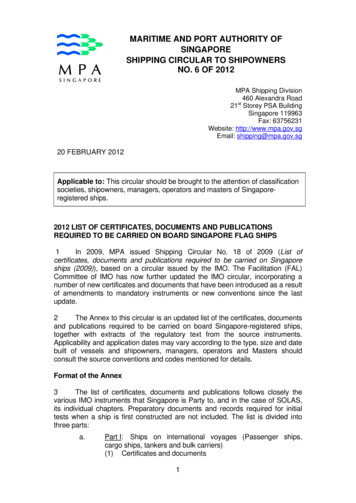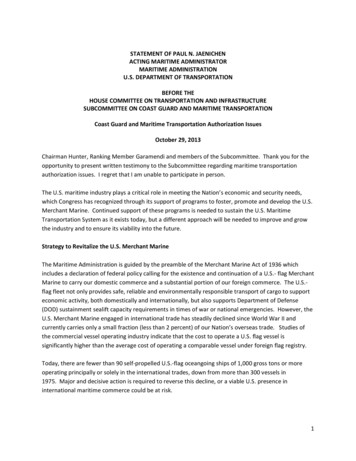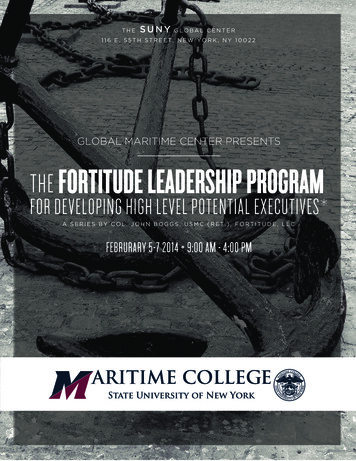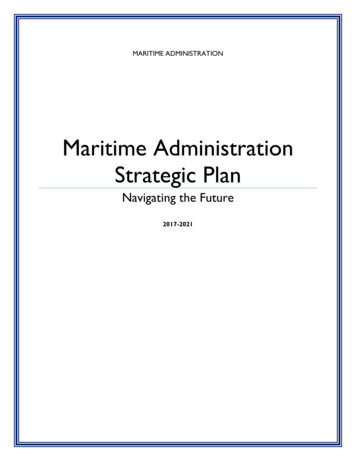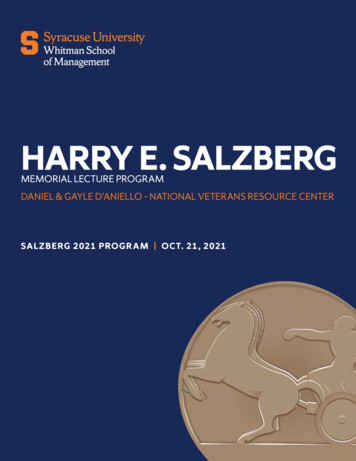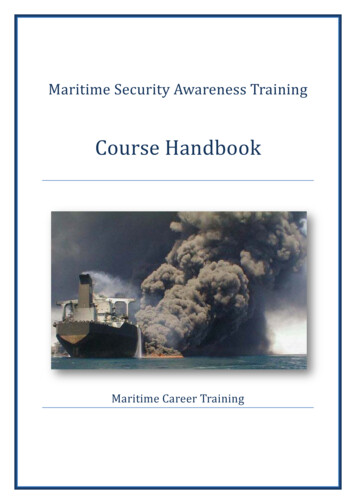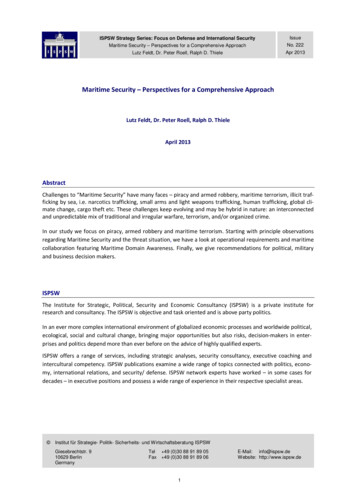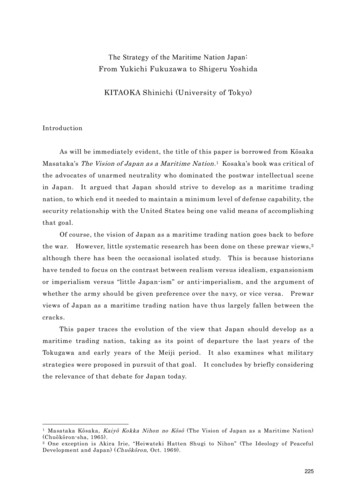
Transcription
The Strategy of the Maritime Nation Japan:From Yukichi Fukuzawa to Shigeru YoshidaKITAOKA Shinichi (University of Tokyo)IntroductionAs will be immediately evident, the title of this paper is borrowed from KōsakaMasataka’s The Vi s i on of Japan as a Mar i t i me Nation . 1 Kosaka’s book was critical ofthe advocates of unarmed neutrality who dominated the postwar intellectual scenein Japan.It argued that Japan should strive to develop as a maritime tradingnation, to which end it needed to maintain a minimum level of defense capability, thesecurity relationship with the United States being one valid means of accomplishingthat goal.Of course, the vision of Japan as a maritime trading nation goes back to beforethe war.However, little systematic research has been done on these prewar views, 2although there has been the occasional isolated study.This is because historianshave tended to focus on the contrast between realism versus idealism, expansionismor imperialism versus “little Japan-ism” or anti-imperialism, and the argument ofwhether the army should be given preference over the navy, or vice versa.Prewarviews of Japan as a maritime trading nation have thus largely fallen between thecracks.This paper traces the evolution of the view that Japan should develop as amaritime trading nation, taking as its point of departure the last years of theTokugawa and early years of the Meiji period.strategies were proposed in pursuit of that goal.It also examines what militaryIt concludes by briefly consideringthe relevance of that debate for Japan today.Masataka Kōsaka, Kaiyō Kokka N i hon no Kōsō (The Vision of Japan as a Maritime Nation)(Chuōkōron-sha, 1965).2 One exception is Akira Irie, “Heiwateki Hatten Shugi to Nihon” (The Ideology of PeacefulDevelopment and Japan) ( Chuōkōron , Oct. 1969).1225
1. The Significance of Naval Power in the Final Years of the Tokugawa Period and atthe Time of the RestorationThe shock of western intrusion at the end of the Tokugawa period was above allthe shock of confronting modern naval power.It was an objective truth that the“black ships,” as Western naval vessels were then known, were militarily farsuperior. 3Nonetheless, not everyone regarded that superiority as a serious threatto their country’s security.In Qing-Dynasty China and Korea, that realization waslate to take root and be recognized widely.Japan, by contrast, was immediatelyaware of the danger that the black ships posed, for two reasons.First, Japan’sgeographical features and socioeconomic conditions made it highly vulnerable toWestern naval power.Second, the country’s leaders, being from the warrior class,were accustomed to seeing things within a military framework.At the time, Japan already possessed a highly integrated national market.The whole country was united by means of a series of coastal navigation routesconverging on Ōsaka.Japan.Hence the black ships presented a direct threat to all ofThey were also able to menace the political heart of the country bypenetrating deep into Edo Bay.For China, on the other hand, the threat of the West was largely confined to thesouthern regions.The Opium War (1840-42) was fought south of Nanjing, and theports that China was forced to open in consequence of its defeat were all locatedsouth of Shanghai.It was not until the Arrow War of 1856-60 that Beijing wasthreatened and occupied.little on coastal trade.Moreover, the Chinese economy as a whole dependedIn the case of Korea, Seoul could be reached from the oceanvia the Han River, but any foreign attacker faced considerable difficulties, for theestuary was long and shallow.This geographical configuration was one of the chiefreasons that the Korean government, committed to a policy of “expelling thebarbarians,” was able to repel a French fleet in 1866 and an American fleet in 1871.In addition, the Korean economy as a whole was neither highly integrated nor verydependent on coastal navigation.Moreover, as mentioned earlier, Japan’s warrior class was keenly aware of howmilitarily effective the black ships were.Toshiakira Kawaji, who was appointedC. M. Cipolla, Guns, Sails and Empires: Technolog i cal Innovation and the Early Phases o fEuropean Expansion (Pantheon Books, 1965).3226
negotiator with the Russian admiral E.V. Putiatin, was amazed at the sheer audacityof the Russian: Putiatin had traveled halfway around the world to Japan, thoughtnothing of setting sail in storms into which no Japanese would have dared to ventureout, and even tried to attack a stronger Anglo-French naval force in the midst of theCrimean War.A “magnificent hero” was how Kawaji effusively described him. 4While Japan’s leaders hailed from the warrior class, those of China and Korea weremandarins who were not very familiar with thinking in military terms.In these circumstances Japan threw considerable resources into purchasingand building modern ships.At the time of Commodore Perry’s arrival Japan did notown a single Western-style vessel, but in the fifteen subsequent years leading up tothe Restoration it was to acquire some 190.These varied widely in tonnage andcapabilities. Japan’s first modern vessel, the Kankōmaru , a gift from Holland,weighed 400 tons, and the Kanr i nmaru , which crossed the Pacific, weighed 250-350tons.By the end of the Tokugawa period, however, at least one vessel, theKa i yōmaru , reached 2,700 tons. 5Whether these ships really possessed sufficient combat capability is debatable.Their transport capacity, however, had a decisive effect on political developmentsduring the waning days of the Bakufu.The domain of Satsuma was able to exercisegreat influence on the national scene because it possessed vessels capable oftransporting over a thousand troops each.The repeated visits of the Shogunate tothe nominal capital of Kyoto were all made by sea.When Enomoto Takeaki chose tomake a final stand against the new government in the fortress of Hakodate, he did soin the belief that he enjoyed naval superiority.Modern ships also played a key role in the politics of the early Meiji period.In1874 Japan launched its first overseas military expedition with the dispatch of anarmed force to Taiwan, something that would have been impossible without a fairlysubstantial fleet.During the Satsuma Rebellion the government’s armies hadenjoyed superiority because of the ease with which it was able to transport men andSeizaburō Satō, “Kawaji Toshiakira,” in Satō, Sh i no Chōyaku o Koete (Beyond the Leap ofDeath) (Toshi Shuppansha, 1992).5 Park Young June, “Bakumatsuki no Kaigun Kensetsu Saikō: Katsu Kaishū no ‘Sempu’ Saikentōto ‘Kaigun Kakumei’ no Kasetsu” (A Reconsideration of Navy Construction at the End of theTokugawa Period: A Reexamination of Katsu Kaishū’s “Sempu” and the Hypothesis of a “NavalRevolution”), in Gun j i Shigaku (The Journal of Military History) No. 150 (Vol. 38, No. 2 (Sept.2002)). This is an excellent study that offers an important new perspective on Japanese navalhistory starting with a reexamination of Katsu Kaishū’s writings, which are considered seminalto any understanding of naval construction in the waning days of the Bakufu.4227
materiel by sea.Although the government’s land forces were superior, if it had notenjoyed an overwhelming advantage in sea transport as well, Saigō’s troops couldprobably have overrun the whole of Kyūshū, putting the new government in adifficult political position.As is well known, Mitsubishi played a prominent role inboth the Taiwan expedition and the Satsuma Rebellion, chalking up massive profitsin the process.As these examples suggest, the Meiji government gave priority not just toconstructing modern vessels but also to encouraging development in the relatedfields of sea transport, trade and industry.In the field of sea transport, for example,it gave preferential treatment to Mitsubishi, which as a result was able to driveforeign vessels out of Japanese coastal waters and expand to shipping routes in Asia.At the same time the government encouraged direct exports with the intention ofensuring that the profits from trade went into Japanese pockets.Right in themiddle of the Satsuma Rebellion, Toshimichi Ōkubo boldly decided to hold Japan’sfirst domestic industrial exhibition; that demonstrates that Ōkubo was not merelysatisfied with pacifying the country but was also determined to promote itsindustrial development.2. Mid-Meiji Arguments for Expanding the Navy and Becoming a Maritime PowerIn the 1880s Japan went into conflicts with China over the issue of Korea.However, in 1882 and again in 1884 it was outmaneuvered by the Chinese in twopolitical struggles in Korea (the so-called Jingo and Kōshin incidents).reason for these setbacks was Japan’s naval inferiority.The biggestAt the time Chinapossessed several 7,000-ton-class warships such as the Zhenyuan and Dingyuan .These were state-of-the-art vessels for the day, while the best that Japan couldmuster were ships in the 4,000-ton class.In 1886 China’s Beiyang Fleet, to whichthese giant warships belonged, visited Japan and caused diplomatic problems whenits sailors went on a rampage.Until that point Japan had held back on building up its navy, due to thedeflationary policies of Matsukata Masayoshi.However, when it became clear thatJapan had fallen behind China in this regard, it launched an ambitious shipbuildingprogram.The biggest subject of debate during the Diet’s first few years(1890-1894) was the question of strengthening the military, especially the navy.228
In November 1890, when Prime Minister Aritomo Yamagata delivered a policyspeech during the first session of the Imperial Diet, he made the famous remark thatJapan needed to assert influence over its “line of interest” as well as defend its “lineof sovereignty.”It is intriguing that, while Yamagata was the senior figure in thearmy, the first step to asserting control over Japan’s “line of interest” would have tobe an expansion of the navy.The Sino-Japanese War ended in victory for Japan in 1895, but as a result ofthe so-called Triple Intervention Japan was forced to return the Liaodong Peninsulato China.Then, in 1898, Russia, France and Germany, the three countries that hadorganized the intervention, led the rush to win territorial leases from the Chinesegovernment, and China’s breakup appeared imminent.The member of the intellectuals who most vociferously supported the race withChina and then Russia to expand the navy was Yukichi Fukuzawa.He became aspirited advocate of a military buildup in the aftermath of the Jingo incident of1882 6 and he emphasized in particular the importance of strengthening the navyrather than the army. 7It is well known how he later became an enthusiasticsupporter of the 1894 war with China.He donated 10,000 out of his own pocket tothe war effort, the third largest donation from anyone in the country.It was a trulyextraordinary amount for a private individual who was neither a former feudal lordnor a leader of the za i batsu or financial conglomerates. 8Fukuzawa accepted the Triple Intervention that followed the Sino-JapaneseWar, recognizing that there was no other choice, and continued to advocate furtherbuilding up the navy.In military matters, he argued, balance was important: in thecase of a continental state, the military power of its neighbors served as thebenchmark, but Japan, being surrounded by water, needed to achieve predominancein the East, particularly vis-à-vis Russia, France and Germany.To that end, hecontended, Japan should spend all the war indemnity it received from China onexpanding the navy and even raise taxes if need be. 96 “Tōyō no Seiryaku Hatashite Ikansen” (What Political Strategy to Adopt in the East) ( Ji jiSh i mpō , Dec. 7-12, 1882), in Fukuzawa Yukich i Zenshū (Complete Works of Yukichi Fukuzawa;hereafter abbreviated as Zenshū ), Vol. 8 (Iwanami Shoten, 1958;).7 “Heibi Kakuchō” (Military Expansion) ( Ji ji Shimpō , Dec. 11, 1885), in Zenshū Vol. 10.8 Masafumi Tomita, Kōshō: Fukuzawa Yuk i chi (A Historical Investigation of Yukichi Fukuzawa),Vol. 2 (Iwanami Shoten, 1992).9 “Tada Kannin Subeshi” (We Must But Endure) ( Ji j i Sh i m pō, Jun. 1, 1895), “Nisshin Dōmei TōteiOkonawaru Bekarazu” (Sino-Japanese Alliance Absolutely Out of the Question) ( ibid ., Jun. 6,1895), “Nihon to Eikoku no Dōmei” (An Alliance between Japan and Britain) ( ibid ., Jun. 21, 1895)229
But Fukuzawa was not arguing that Japan should achieve dominance all on itsown.He believed that Japan needed some type of ally, for he felt that the lack of anally was the reason that the Triple Intervention had occurred in the first place.Some asserted that China would be a suitable partner for an alliance, but Fukuzawadisagreed, favoring an alliance with Britain instead.He countered doubts aboutwhether Britain would even be amenable to such an alliance by averring that, sinceit was willing to ally itself with Turkey and China, it would most certainly be willingto ally itself with Japan. 10Fukuzawa’s desire for a partnership with Britain was motivated by more thanjust considerations of balance of power.He had from early on been convinced thatJapan needed above all to develop as a trading nation.And since global tradecentered around Britain and the United States, he argued that learning Englishshould be the first priority. 11Always careful to observe where Japan enjoyed acomparative advantage, he also stressed that Japan should lose no time in shiftingthe mainstay of its economy from rice growing to silk production, and production ofhigh-grade silk at that; otherwise Japan would be unable to compete against Chinawith its low wages. 12In 1898, when tensions with Russia were on the rise, Fukuzawa wrote ofJapan’s China policy in the following terms.“Our true objective is not China’s land;no matter to whom the land belongs, it is not of the least concern to us, as long asthere is no obstacle to freedom of commerce.nothing else.Our sole desire is commerce andWe are dealing with a country of over four hundred provinces withseveral hundred million people; once it opens up, it will take in merchandise fromaround the world, and the more the better.It is fair to say that the future ofJapanese commerce is bright indeed even if it should be restricted to China alone.” 13Fukuzawa was not the only one to argue along these lines.influential magazine of the day, editorialized in the same vein.Taiyō , the mostDuring a visit toJapan in the fall of 1898, Charles Peresford, a member of the British House of Lords,and “Gunkan Seizō no Mokuteki” (The Purpose of Building Warships) ( ibid ., Jul. 16, 1895), all inZenshū Vol. 15.10 For example, “Nihon to Eikoku no Domei” ( Jij i Shimpō , Jun. 21, 1895), in Zenshū Vol. 15.11 “Wagakuni Futsū no Yōgaku wa Eigo ni Kisu Beshi” (Western Studies in Japan Should Beginwith Learning English) ( Ji ji Sh i mpō , Dec. 28, 1883), in Zenshū Vol. 9.12 “Nihon no Yōsanka wa Shina no Kyōsō o Wasuru Bekarazu” (Japanese Silk Producers: Don’tForget the Chinese Competition) ( Ji ji Shimpō , Aug. 5, 1887), in Zenshū Vol. 11.13 “Shōkō Rikkoku no Hoka ni Michi Nashi” (There Is No Other Path to National Growth butIndustry and Commerce) ( Ji ji Shimpō , Feb. 25, 1888), in Zenshū Vol. 16.230
enthusiastically made the case for a four-way alliance between Japan, Britain,America and Germany, which quartet of nations, he contended, should work togetherto maintain the status quo in China.In this way, he evidently thought, Britishcommercial interests could be protected.Taiyō gave considerable prominence toPeresford’s views, welcoming and supporting British arguments for an alliancebetween Britain, Japan and America. 14In 1902 Ta i yō published a special issue entitled “Umi no Nihon” (Japan of theSea).The back cover carried — in English — the slogan, “International Peace andProsperity Depend Upon Enlightened Commerce and Industry,” as well as a blurbdescribing the magazine: “Published Monthly in English and Japanese: a FaithfulExponent of Oriental Affairs, Especially Devoted to Commerce and Industry.”In apiece entitled “Gunkoku to Shōgyō Seisaku” (Militarism and Commercial Policy), themagazine’s editor, Shuntei Tōyabe, pointed out that the great powers were all vyingto build up their navies “in line with a single clear principle.”That principle as hedefined it was “a principle whose goal is commercial expansion, rather than onerooted in policies of territorial invasion.”Thus the case for naval expansion in the mid-Meiji period, whether as made byFukuzawa or Taiyō , was inextricably bound up with the vision of Japan as a tradingnation.It also tied in with the opinion that the country should ally itself withBritain and America.The principles of the open door and equality of opportunityadvocated by the Americans, dovetailed nicely with Japanese views on themaintenance of China’s integrity.In East Asia on the eve of the Russo-JapaneseWar, Japan, Britain and America stood at loggerheads with Germany, France andRussia in what was effectively a confrontation between sea-based and land-basedpowers.But did the vision of Japan as a maritime trading state inevitably entail anaval buildup? And did it require a commitment to the Korean peninsula?As Yamagata stated in his speech before the first Diet, Japan would find itsroom for maneuver seriously hampered if it was unable to assert its influence in theKorean peninsula — if, to put it another way, the Korean government fell under theKitaoka, “Shoki Ta i yō ni Miru Amerika-zō: Nisshin Nichiro Senkanki Nihon Gaikō ni KansuruIchikōsatsu” (The Image of America in Early Issues of Taiyō : An Observation on JapaneseDiplomacy between the Sino-Japanese and Russo-Japanese Wars), in Sadami Suzuki, ed., Zassh iTa i yō to Kokum i n Bunka no Keisei (The Magazine Taiyō and the Making of a National Culture)(Shibunkaku Shuppan, Jul. 2001).14231
sway of a third country hostile to Japan, or an unfriendly foreign power obtained alease of territory on the south coast of the peninsula.Such fears were not wholly misplaced.The Russians had briefly occupiedTsushima in the waning days of the Tokugawa Bakufu, and after the Koshin incidentthe British had occupied Komun-do, in Cholla Namdo, for two years beginning in1885 in an effort to stem the tide of Russian expansion.Later, in February 1896,Korea’s King Kojong and the Crown Prince fled the palace and took refuge in theRussian legation, where they remained for a year.government fell completely under Russian influence.attempted to acquire a lease on land in Masan.With this the KoreanThen, in March 1900, RussiaRussia already held the strategicport of Vladivostok and in 1898 had succeeded in obtaining a lease on Port Arthur;hence it made perfect military sense for Russia to try to secure a naval base on thesouth end of the Korean peninsula in order to guard the sea route linking these twopoints.The Russian occupation of Masan, had it occurred, could well have beenfatal to the Japanese Navy; after all, four years later, at the outset of theRusso-Japanese War, the Russian navy constantly menaced communicationsbetween Japan and the mainland.Therefore, in light of international conditions atthe time, it was of decisive importance— just as Yamagata insisted — to prevent thesouthern end of the Korean peninsula from falling into the grip of any of the othergreat powers if Japan was to evolve as a trading nation.3. The Army and Navy Clash in the Aftermath of the Russo-Japanese WarHere I would like to turn briefly to the question of civilian control in modernJapan.The concept of civilian control is in origin, I believe, an Anglo-American one.It could only have arisen where the ocean acted as a buffer against foreign invadersand there was no fear of sudden attack from a hostile neighbor.Establishment of civilian control is predicated on a second assumption as well,namely the existence of a stable political system.If the government is unstable andpolitics are susceptible to military interference, the army will end up taking control.To begin with, the army possesses overwhelming manpower.Its commanders enjoygreater opportunity to interact with politicians and bureaucrats than do those of thesea-based navy.Above all, it has the final say in any attempt to seize power.The army had exercised considerable influence over the course of Japanese232
politics since the end of the Tokugawa period and the Meiji Restoration.construction of a navy was never put on the back burner as a result.ButThat, I wouldargue, was because the country’s entrenched leadership, known collectively as thehanbatsu (or “domain cliques” because their base of power lay originally in tutedakindofundifferentiated military-civilian elite that provided a form of civilian control.Despite the bitter conflicts that erupted between different groups within this elite,particularly between the Satsuma and Chōshū factions, its members shared a senseof pride and responsibility as the architects of Meiji Japan, and they never lost sightof the need to work together when it really counted.Moreover, the majority of themwere, in origin, samurai who had lived through the revolutionary upheavals of theRestoration; thus even the civilian officials among them, like Toshimichi Ōkubo andHirobumi Itō, had no aversion to or hesitation about using the military.Yamagata’sdetermination to build up the navy although he himself was an army officer is oneexample of the hanbatsu model of civilian control.It is hardly surprising, then, that friction between the army and navyintensified as hanbatsu dominance went into decline after the Russo-Japanese War.As the result of the Russo-Japanese War, Japan won considerable interests onthe mainland.priority.The protection of these interests thereafter became a nationalIndeed, the Imperial Defense Policy for 1907 made that an explicitobjective, albeit from the army’s perspective. 15But the navy refused to be satisfied with a subordinate role and, with theappearance of the Dreadnought -class of battleship, was adamant about the need tokeep abreast of the new technology.Thus Japan ended up giving precedence tonaval expansion. Moreover, by around 1911 Japan had largely asserted control overthe interests in Manchuria and Mongolia that it had acquired in the aftermath of theRusso-Japanese War.It was in the context of these developments that in 1913 themagazine Taiyō published a special issue entitled “Nanshin ka Hokushin ka?”(Advance South or North?).Meanwhile, in 1912, the army proposed adding two newdivisions to its existing forces, a move intended to counter the priority being given tothe naval buildup.In the early Taishō years the conflict between the two servicesoften plunged cabinets into crisis and even led to a cabinet’s downfall.This state ofShinichi Kitaoka, Nihon Rikugun to Ta i r i ku Seisaku (The Japanese Army and ContinentalPolicy) (University of Tokyo Press, 1978).15233
affairs resulted from the hanba t su ’s dwindling ability to provide unified leadership.With the outbreak of World War I in 1914, this confrontation ended, at least forthe mid-term, in victory for the army and its view that Japan should seek acontinental empire.And so Japan proceeded to strengthen its interests on themainland with a series of policies beginning with the Twenty-One Demands.4. Visions of Japan as a Trading Nation between the WarsIn the 1920s the vision of Japan as a maritime nation came to predominate, astypified by Tanzan Ishibashi.Ishibashi argued that “Greater Japan-ism” was achimera, for Japan derived no benefit whatsoever from either Korea or Taiwan orGuandong (Kwantung) or Sakhalin in terms of the amount of trade that theygenerated.The idea of extending the country’s borders, he contended, was in theend a timid idea in that it reflected a desire to remain confined within those borders;it would be far more ambitious to expand beyond them through trade.As fornational security, war was most likely to break out on the front lines in Korea,Taiwan or Manchuria, and the Sea of Japan was more than adequate as Japan’s lineof defense; he therefore proposed abandoning those colonies. 16Ishibashi’s vision ofJapan as a maritime state harked back to that of Fukuzawa, especially in that boththinkers gauged Japan’s interests in terms of volume of trade.Another figure who may be cited in this regard is Kiyoshi Kiyosawa.Kiyosawa contended that Japanese interests in Manchuria and Korea were sovulnerable that they could not survive without the protection of the government.He was particularly critical of Japanese policy in Manchuria: Japan’s fixation onManchuria could damage relations with China, a far more important trading partner,and that in turn could damage relations with America, an even more importanttrading partner. 17The 1920s marked the apogee of the moderate diplomatic policies of foreignminister Kijūrō Shidehara.The Takaaki Katō cabinet considered the Japanesesphere of interest on the mainland to be confined to southern Manchuria and theeastern part of Inner Mongolia.Shidehara — though not as radical as Ishibashi —Tanzan Ishibashi, “Dainihon Shugi no Genei” (The Illusion of Greater Japan-ism) in TakayoshiMatsuo, ed., Ish i bashi Tanzan Hyōronshu (Anthology of Writings by Tanzan Ishibashi) (IwanamiShoten, 1984).17 Kitaoka, Kiyosawa Kiyoshi (Chuōkōron-sha, 1987).16234
held a similar view in that he argued for steadily asserting Japan’s legal interestsand promoting trade as the chief engine of national growth.The ascendancy of this vision of Japan as a trading state was made possible bythe situation on the international stage.The turmoil that followed the RussianRevolution meant that Russia (or the Soviet Union), which the Japanese army hadtraditionally regarded as a potential adversary, had ceased to be a threat for thetime being.China too was prostrate.As for the United States, the WashingtonConference of 1921-22 had produced an agreement under which, while Japan couldretain only 60% of the capital ships of the US, the Americans too had to maintain thestatus quo with respect to their naval bases in the West Pacific.Hence that countrydid not have enough naval power to pose a direct threat to Japan.By the late 1920s, however, the progress of the Chinese revolution wasbeginning to have an impact on the view of Japan as a trading nation.As Chinatried to reclaim the rights that it had ceded to the imperialist powers, it was ShigeruYoshida who argued for taking a hard line against China.In that regard Yoshidawas the single figure within the Foreign Ministry most at odds with Shidehara.That was why Yoshida was appointed vice minister of foreign affairs in TanakaGiichi’s Seiyūkai cabinet, which had been formed in part in opposition to Shidehara’sforeign policy.Yoshida was even more intransigent than the army, asserting thatJapan should defend its interests in Manchuria with force if need be. 18On the other hand, Yoshida also stated categorically that Japan’s commercialinterests were the most profitable of all its overseas interests. 19This was anunderstandable enough contention for Yoshida, who had been brought up in amerchant household.But promoting trade in areas such as Manchuria wouldrequire enforcing the treaties that guaranteed Japanese interests, Yoshida believed;commerce could not thrive in the absence of such legal foundations.This system ofunequal treaties was at the time recognized and indeed considered necessary byBritain as well.Thus Yoshida’s hard-line diplomacy was intimately connected tothe policies of enforcing the treaties and cooperating with Britain, and it may beExamples of studies that present this conventional view of Yoshida are Shinya Bamba, ManshūJihen e no Michi: Sh i dehara Ga i kō to Tanaka Gaikō (The Road to the Manchuria Incident:Shidehara Diplomacy and Tanaka Diplomacy) (Chuōkōron-sha, 1972) and John Dower, Emp i reand A f termath: Yosh i da Sh i geru and the Japanese Exper i ence (Harvard University Press, 1979).19 Letter of Jul. 25, 1916 to Makino Nobuaki, in Yoshida Shigeru Kinen Jigyōkai (Yoshida ShigeruCommemorative Project Committee), ed., Yosh i da Sh i geru Shokan (Letters of Yoshida Shigeru)(Chuōkōron-sha, 1994).18235
considered an extension of the idea of Japan as a trading nation.5. The Wars of the Shōwa Period and Shigeru YoshidaThe Manchurian Incident of 1931 was decisive in cutting Japan’s ties with thepolicy of international cooperation.The outbreak of the Great Depression hadalready dealt a blow to Japan’s internationalists by driving Britain and the UnitedStates to adopt protectionist policies.Procuring resources was one of the mainjustifications for the Manchurian Incident. 20Subsequently autarky — the pursuitof economic self-sufficiency — came to be regarded increasingly as the ideal.The key question, however, is whether or not trade continued to occupy acentral place in national policy.Shigeru Yoshida, for whom Japanese interests in Manchuria were a primaryconcern, was not completely supportive of the Manchurian Incident.At the veryleast, he was critical of the way that the affair had been pulled off with totaldisregard for the views of Britain and America.He was to remain convinced of theimportance of improving relations with Britain and America:when war broke outwith China, he formulated a peace plan involving Britain as mediator, and heopposed any alliance with Germany.The upshot was that many diplomats who had once been more in favor ofinternationalhard-line. moreYoshida and Shidehara found themselves less at loggerheads, andYoshida came to be on close terms with Kiyoshi Kiyosawa and Tanzan Ishibashi, theerstwhile advocates of “little Japan-ism,” because they now shared the sameperspective. 22All four basically rejected the foreign policy that Japan had pursuedsince the Manchurian Incident and criticized the way that Japan had abandonedcooperating with Britain and the United States, and all emphasized the impor
in Japan. It argued that Japan should strive to develop as a maritime trading nation, to w hich end it needed to maintain a minimum level of defen se capability, the security relationship with the United States being one valid means of accomplishing that goal. Of course, the vision of Japan as a maritime trading nation goes back to before the war.


